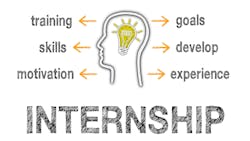When it comes to setting up, recruiting and managing intern programs, the law may have changed a lot over the years but one thing has not: The idea is not to obtain free or cheap labor, but instead to provide real benefits for the interns.
In fact, that is the chief deciding factor when it comes to deciding whether you want to create a program where you choose to pay interns. “Whether an internship must be paid or not depends upon whether the internship primarily benefits the intern or the business,” according to attorney Ayelén R. Rodriguez of the Akerman law firm.
Under the current U.S. Department of Labor (DOL) guidance for employers, an intern does not need to be paid only if the internship is intended to primarily benefit the intern rather than the employer. On the other hand, if an internship primarily benefits the employer, then the intern must be paid. It’s that simple.
To determine whether this is the case, the DOL Wage and Hour Division provides a seven-factor test to evaluate whether an internship primarily benefits an intern or employer. The factors an employer needs to take into account include the extent to which:
1. The intern and the employer clearly understand that there is no expectation of compensation.
2. The internship provides training similar to the training provided in an educational environment, including clinical and other immersive training provided by educational institutions.
3. The internship relates to the intern’s formal education program, whether through integrated coursework or the receipt of academic credits.
4. The internship accommodates the intern’s academic commitments by aligning with the intern’s academic calendar.
5. The internship’s duration is limited to the period in which the internship provides the intern with beneficial learning.
6. The intern’s work complements, rather than displaces, the work of paid employees while providing significant educational benefits to the intern.
7. The intern and the employer understand that the internship is conducted without entitlement to a paid job at the conclusion of the internship.
If worse comes to worst and you end up in court, making sure that you adhere to these guidelines will help. “Courts will weigh each factor in light of the individual circumstances, and no one factor is dispositive,” Rodriguez points out. “Not every factor is required to point in the same direction for the court to still conclude an intern is not an employee.”
Of course, as is often the case when dealing with employment regulation, it is not just federal requirements that employers need to be concerned about; a number of states have their own laws. “Some states solely consider the DOL’s seven factors, while others may have more stringent requirements,” she notes.
Other factors need to be kept in mind as well, she stresses. In general, paid internships are considered to be regular employment and interns are subject to the same wage and hour laws as regular employees. Employers must pay paid interns at least the applicable minimum wage and overtime wages.
Also keep in mind that a paid intern who continues to work full-time after 90 days may become eligible for certain other benefits as well.
Create a Good Intern Program
That leaves the question of how a diligent employer goes about creating a worthwhile intern program that supplies real benefits for the interns. It’s never too late to absorb good advice in this regard, even if you can only apply in the future because your current intern program is already well underway.
The No. 1 priority for making sure your intern program is a success is to make sure the interns are provided with real work, suggests the National Association of Colleges and Employers (NACE), which also advocates for paying interns as a best practice for employers who are seriously considering going this route.
“By paying your interns, you are increasing the size and diversifying your pool of potential interns,” NACE argues. “Many students cannot afford to forgo a paycheck for the summer, so they will not even be in your pool for consideration. Paid internships support an inclusive candidate pool.”
You also should make sure that your interns are doing work that is related to their college major and/or skill set, that is challenging, that is recognized by the organization as valuable, and that fills the entire work term, NACE says. This is especially necessary if you are considering your intern to be a recruiting tool for adding to your employee ranks in the future, something that the association highly recommends that you do.
Maintaining communications throughout the process is one of the keys to making the intern experience worthwhile. You can guarantee that hiring managers provide real work assignments by checking job descriptions, emphasize the importance of real work assignments during manager/mentor orientation sessions, and communicate with interns frequently throughout the work term to determine how they perceive what they are doing, NACE suggests.
Make sure to hold an orientation session for program managers and mentors as well as a session for the student interns. “Orientations ensure that everyone starts with the same expectations and role definitions.” In addition, provide interns with a handbook and/or website that answers their frequently asked questions and which communicates your company’s work rules “in a warm and welcoming way,” NACE recommends.
Rodriguez also emphasizes that employers should make sure that all employees and interns are aware of company culture and policies, as well as all applicable anti-harassment and discrimination laws.
For unpaid internships, she emphasizes that employers should create internship program policies and practice guidelines to make clear that the intern is the primary beneficiary of the internship. If an intern is a student, employers should structure the unpaid internship so that the intern is able to receive academic credit at their respective school or university, and align the duration and timing of internship programs with academic calendars, she adds.
NACE says that exit interviews are important as well. “Whether face-to-face or via Zoom or phone, a real-time exit interview done by a member of the college relations team is an excellent way to gather feedback on the student’s experience and to assess their interest in coming back. Having the students fill out an exit survey and bring it to the interview gives some structure to the conversation.”
It also is important for employers to collect, track and analyze their program statistics, according to the association. “The only way to ensure your program is effective is to track and analyze related data. This is critical to success—from ensuring you are attracting and securing the students you want to determining how effective your program is at converting interns into full-time hires.”
About the Author

David Sparkman
founding editor
David Sparkman is founding editor of ACWI Advance (www.acwi.org), the newsletter of the American Chain of Warehouses Inc. He also heads David Sparkman Consulting, a Washington D.C. area public relations and communications firm. Prior to these he was director of industry relations for the International Warehouse Logistics Association. Sparkman has also been a freelance writer, specializing in logistics and freight transportation. He has served as vice president of communications for the American Moving and Storage Association, director of communications for the National Private Truck Council, and for two decades with American Trucking Associations on its weekly newspaper, Transport Topics.
